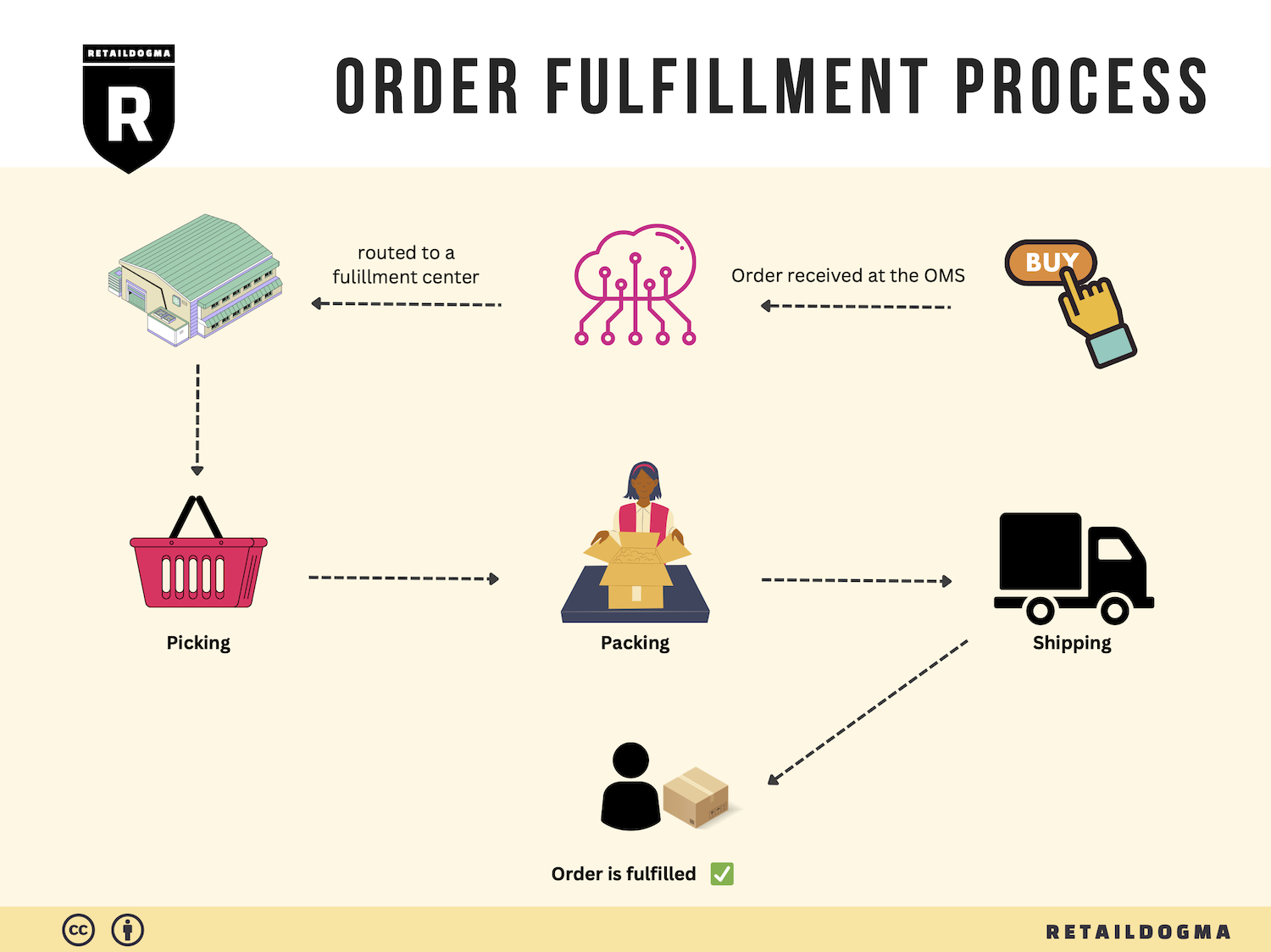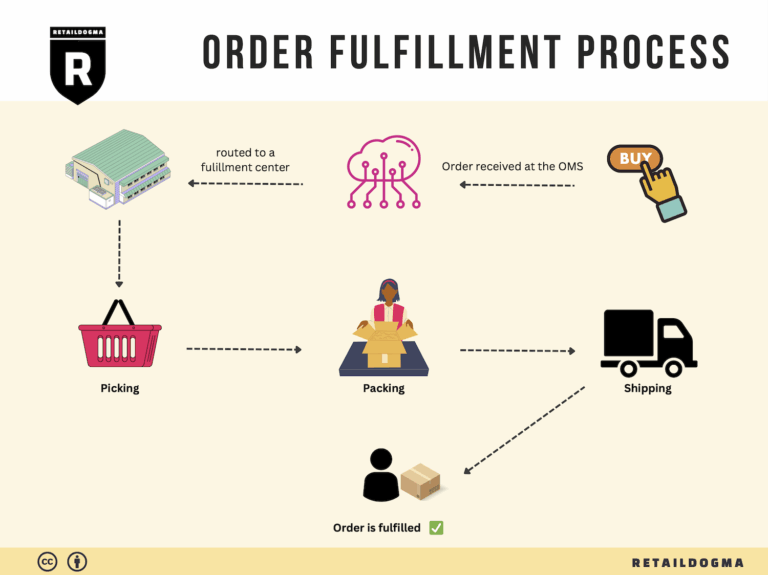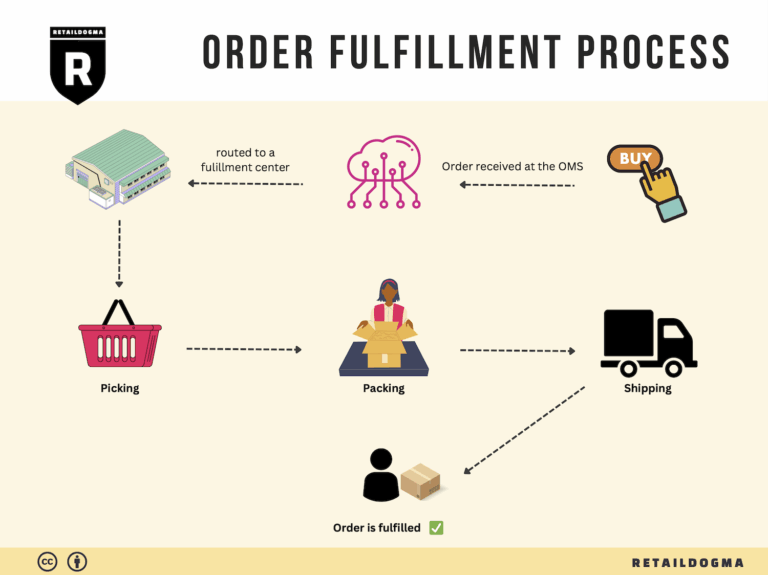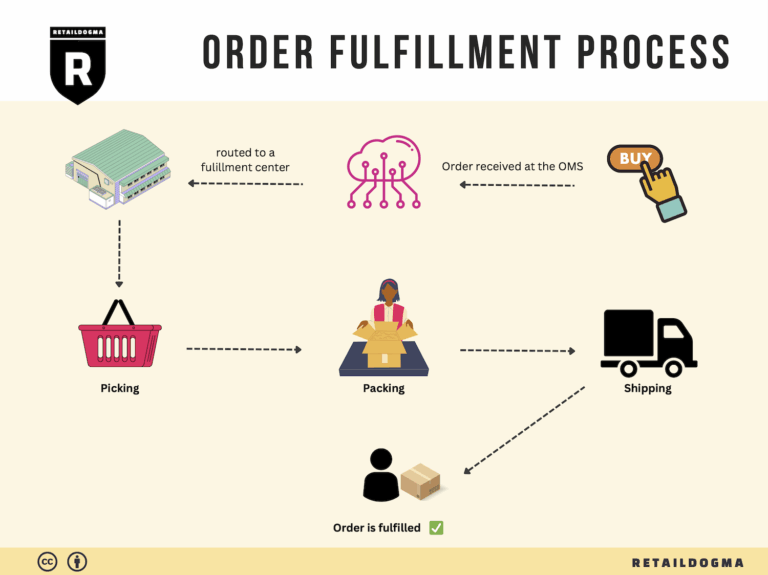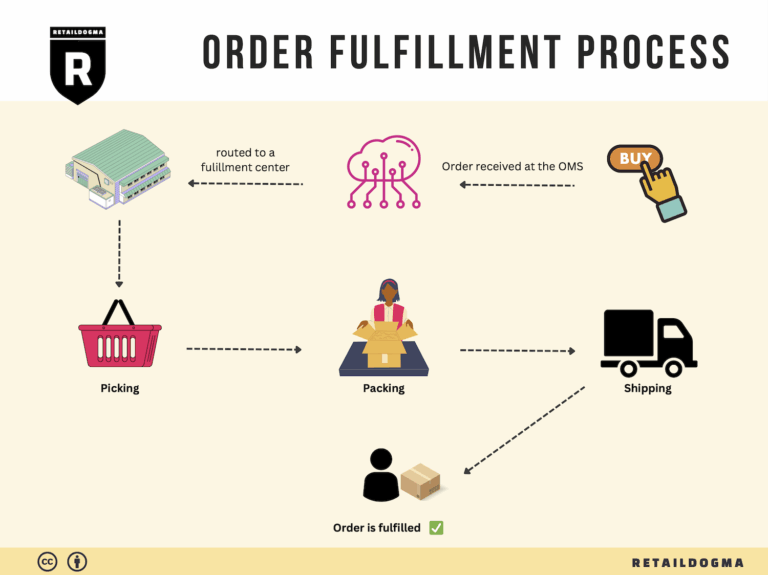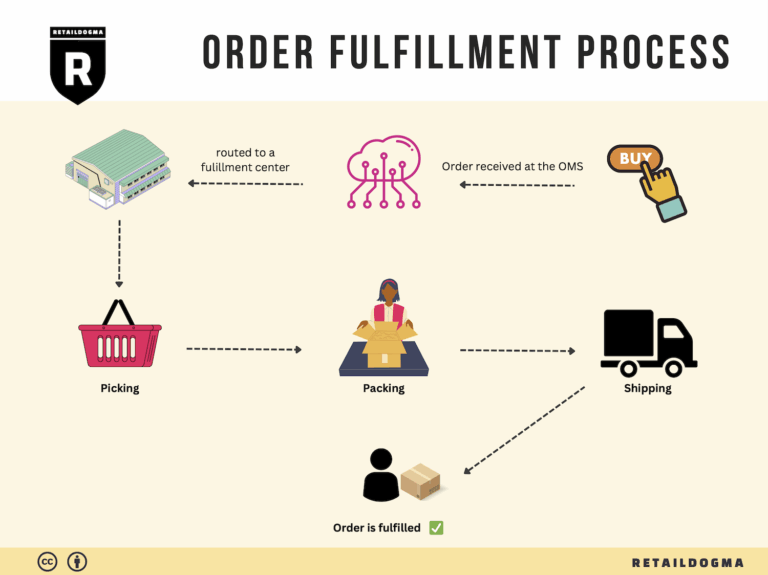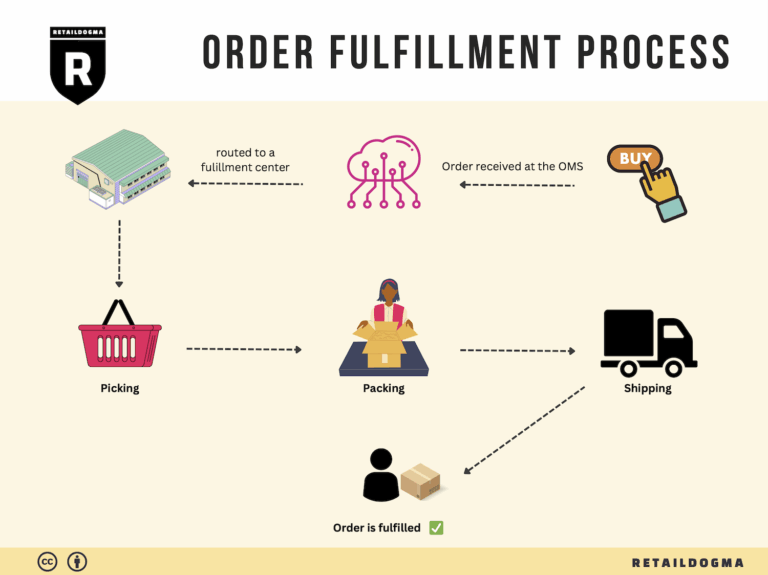How Order Fulfillment Works: A Step-by-Step Guide for Businesses
What is E-commerce Fulfillment? An Introduction for Growing Businesses
Understanding E-commerce Fulfillment
As an e-commerce business owner, you may find yourself overwhelmed by the logistics of packing and shipping orders. The excitement of generating sales can quickly turn into a logistical nightmare, especially as your order volume increases. Managing the complexities of fulfillment—ensuring that products are packed, shipped, and delivered efficiently—can be daunting. However, understanding and optimizing this process is crucial for the growth and sustainability of your business.
At its core, e-commerce fulfillment refers to the entire process of getting a product from your inventory to your customer’s doorstep. This includes everything from receiving and storing inventory to picking, packing, and shipping orders. The fulfillment process is not just about speed; it also involves accuracy and customer satisfaction. A streamlined fulfillment operation can be the difference between a happy customer who returns for future purchases and a frustrated one who leaves negative reviews.
In this guide, we will explore various fulfillment models available to growing businesses, such as Third-Party Logistics (3PL) and Fulfillment by Amazon (FBA). Each model has its own set of advantages and considerations, making it essential to choose one that aligns with your business needs and goals. We will also cover the core services offered by fulfillment partners, including inventory management, order processing, and shipping options.
Selecting the right fulfillment partner is a critical decision that can significantly impact your operations. We will provide practical advice on how to assess potential partners, including factors like scalability, technology integration, and customer service. Additionally, we will delve into pricing structures, helping you understand the various cost components associated with fulfillment services. By comparing rates and services, you can make informed decisions that support your business’s financial health.
Ultimately, this guide aims to empower you with the knowledge and tools necessary to make smart decisions about your logistics. Understanding the nuances of e-commerce fulfillment will enable you to optimize your operations, improve customer satisfaction, and scale your business effectively. Whether you’re just starting or looking to enhance your existing processes, the insights provided here will help you navigate the complexities of fulfillment with confidence.
What You’ll Learn In This Guide
- What is E-commerce Fulfillment? An Introduction for Growing Businesses
- The Order Fulfillment Process: From ‘Buy’ Button to Customer’s Door
- Comparing Fulfillment Models: In-House vs. 3PL vs. Dropshipping
- A Deep Dive into Amazon FBA: Pros, Cons, and Who It’s For
- Core Services Offered by Fulfillment Centers
- How to Choose a Fulfillment Partner: A 6-Point Checklist
- Understanding Fulfillment Pricing: A Breakdown of Common Fees
- Frequently Asked Questions (FAQs) about Fulfillment
- Conclusion: Is Outsourcing Fulfillment the Right Move for Your Business?
- Important Disclaimer
The Order Fulfillment Process: From ‘Buy’ Button to Customer’s Door
1. Receiving Inventory
The order fulfillment process begins with receiving inventory, a critical step that sets the stage for efficient operations. When products arrive at the fulfillment center, they are unloaded from trailers and scanned into the system. This process involves checking the received items against purchase orders to ensure accuracy. Each item is assigned a Stock Keeping Unit (SKU), a unique identifier that facilitates tracking throughout the supply chain.
Why is this step important? Proper receiving is essential for inventory accuracy, which directly impacts order fulfillment speed and customer satisfaction. If inventory is not accurately logged, it can lead to stock discrepancies, resulting in delays and potential lost sales. Efficient receiving processes can also minimize the likelihood of damaged goods entering the warehouse, thereby reducing returns and enhancing overall operational efficiency.
2. Warehouse Storage
Once inventory is received and logged, the next step is warehouse storage. Items are organized and stored in designated locations throughout the fulfillment center. The PAE2 facility, for instance, can accommodate up to 40 million items across its vast 2.9 million square feet. This step often employs sophisticated warehouse management systems (WMS) to optimize storage locations based on factors such as item size, weight, and demand frequency.
The importance of effective warehouse storage cannot be overstated. A well-organized warehouse not only improves space utilization but also enhances the speed of subsequent processes like order picking. Key terms associated with this step include slotting, which refers to the strategic placement of products to minimize travel time for pickers, and FIFO (First In, First Out), a method used to ensure older stock is sold before newer stock.
3. Order Picking
The order picking phase is where the magic happens. When a customer places an order, the fulfillment center generates a pick list—a document that details the items and their locations within the warehouse. Employees or automated systems then retrieve these items from their respective storage locations.
This step is vital because it directly affects the speed and accuracy of order fulfillment. Delays or errors in picking can lead to customer dissatisfaction and increased return rates. Advanced fulfillment centers like PAE2 utilize a combination of human labor and robotics, such as Amazon’s Robin robotic system, to enhance picking efficiency. This hybrid approach allows for faster retrieval of smaller items while reducing the physical strain on human workers.
4. Order Packing
After items are picked, they move on to the order packing stage. Here, products are carefully packed into boxes, often using protective materials to prevent damage during transit. This step also involves labeling packages with shipping information and tracking numbers, which are crucial for logistics.
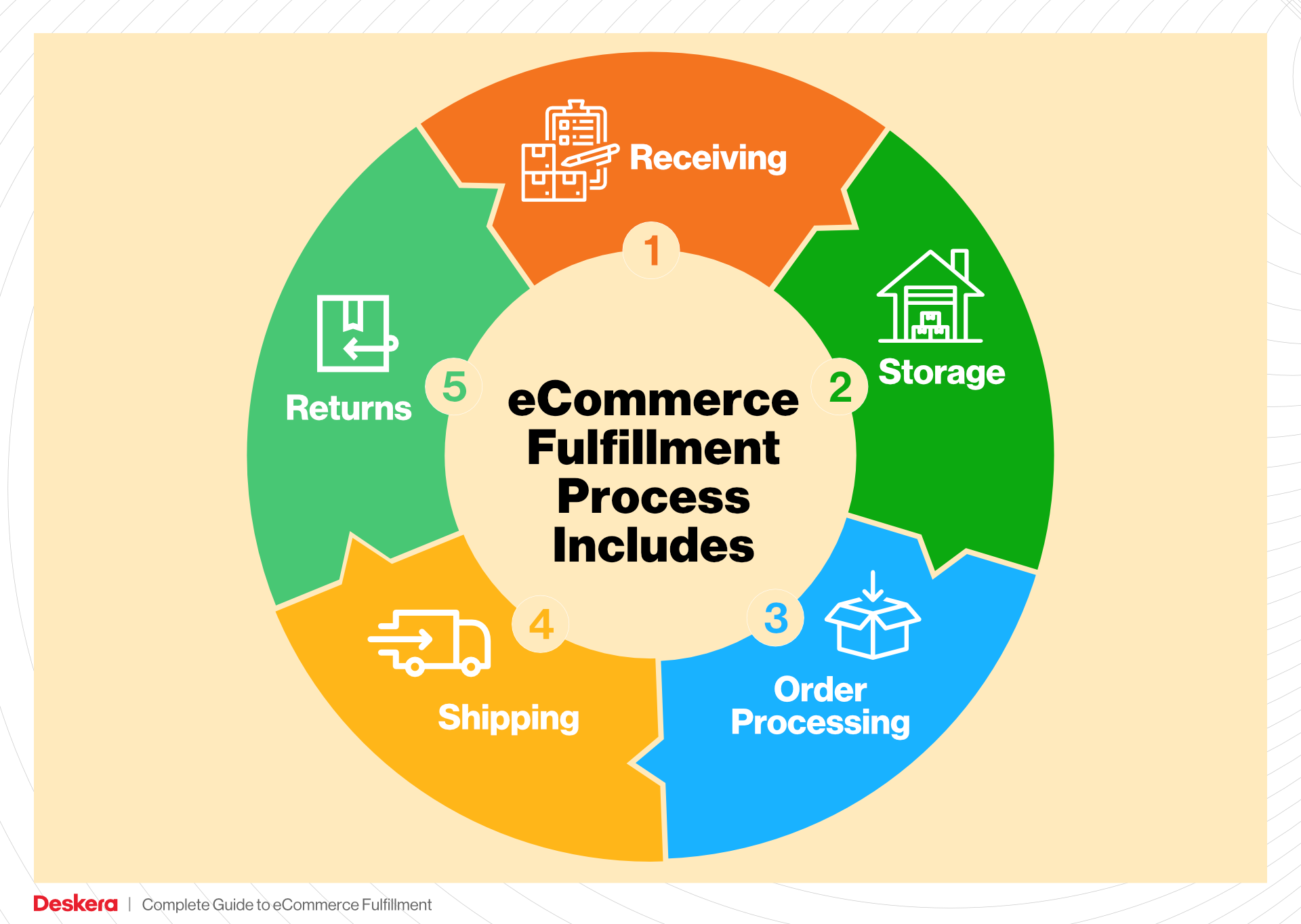
The packing process is significant for several reasons. First, well-packed orders reduce the risk of damage, ensuring that customers receive their products in perfect condition. Second, efficient packing helps optimize shipping costs, as lighter and more compact packages often lead to reduced shipping fees. Key terms related to this phase include packaging materials (such as bubble wrap or packing peanuts) and dimensional weight pricing, which considers the package size in addition to its actual weight for shipping costs.
5. Shipping & Delivery
The final step in the order fulfillment process is shipping and delivery. Once packed, orders are loaded onto delivery trucks and dispatched to their final destinations. Depending on the chosen shipping method, orders may be delivered directly to customers or routed through regional distribution centers for further processing.
This step is crucial as it ultimately determines how quickly and reliably customers receive their orders. Timely shipping enhances customer satisfaction and loyalty, which are vital for repeat business. Key considerations during this phase include last-mile delivery, the final step of the delivery journey, and shipping carriers, which may include services like UPS, FedEx, or Amazon’s own delivery network.
In conclusion, each step in the order fulfillment process—receiving inventory, warehouse storage, order picking, order packing, and shipping & delivery—plays a critical role in ensuring a smooth operation that can scale effectively. By understanding and optimizing each phase, e-commerce businesses can improve efficiency, reduce costs, and enhance customer satisfaction.
Comparing Fulfillment Models: In-House vs. 3PL vs. Dropshipping
Fulfillment Model Comparison Table
| Model | Who Handles Inventory | Best For (Business Stage) | Key Advantage | Key Disadvantage |
|---|---|---|---|---|
| In-House Fulfillment | The business itself | Established businesses | Greater control over inventory and processes | High overhead costs and complexity |
| Third-Party Logistics (3PL) | An external logistics provider | Growing and scaling businesses | Scalable solutions and reduced operational burden | Less control over inventory and processes |
| Dropshipping | Suppliers or manufacturers | Startups and small businesses | Low upfront investment and no inventory risk | Lower profit margins and reliance on suppliers |
In-House Fulfillment
In-house fulfillment refers to the process where a business manages its own warehousing and order fulfillment operations. This model is most suitable for established businesses that have the resources to invest in infrastructure, technology, and personnel. The key advantage of in-house fulfillment is the level of control it offers. Businesses can directly manage inventory levels, optimize picking and packing processes, and maintain quality standards. This control can lead to improved customer satisfaction as businesses can tailor their fulfillment processes to meet specific customer needs.
However, the disadvantages of in-house fulfillment are significant. The overhead costs associated with maintaining a warehouse, hiring staff, and investing in technology can be substantial. Additionally, as order volumes fluctuate, businesses may struggle with scalability. For instance, during peak seasons, such as holidays, the existing infrastructure may be overwhelmed, leading to delays and potential revenue loss. Businesses must carefully evaluate their capacity and readiness to handle fulfillment in-house before committing to this model.
Third-Party Logistics (3PL)
Third-party logistics (3PL) involves outsourcing fulfillment operations to a specialized logistics provider. This model is particularly beneficial for growing and scaling businesses that want to focus on core competencies such as marketing and product development rather than logistics. 3PL providers offer a range of services, including warehousing, inventory management, order processing, and shipping, which can significantly reduce the operational burden on businesses.
One of the primary advantages of using a 3PL is scalability. As a business grows, a 3PL can easily adjust to increased order volumes without requiring the business to invest in additional infrastructure. This flexibility allows businesses to expand into new markets or product lines with minimal risk. However, a key disadvantage is the loss of control over inventory and fulfillment processes. Businesses must rely on the 3PL’s operational efficiency and may face challenges with communication, especially if issues arise. Choosing the right 3PL partner is crucial for maintaining service quality and customer satisfaction.
Dropshipping
Dropshipping is a fulfillment model where a business sells products without holding any inventory. Instead, when a customer places an order, the business purchases the item from a supplier or manufacturer who then ships it directly to the customer. This model is ideal for startups and small businesses that want to minimize upfront investment and avoid the complexities of inventory management.
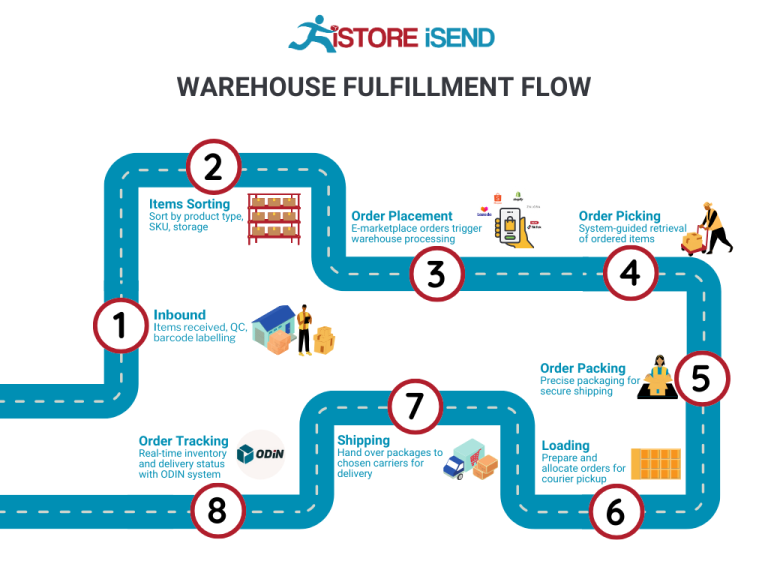
The primary advantage of dropshipping is the low barrier to entry. Entrepreneurs can start an online store with minimal investment, as there is no need to purchase inventory upfront. This model allows for a wide range of products to be offered without the risk of unsold stock. However, dropshipping also comes with notable disadvantages. Profit margins can be thinner compared to traditional retail models, as businesses often pay a premium for the convenience of not handling inventory. Additionally, reliance on suppliers can lead to issues with fulfillment speed and product quality, which can negatively impact customer satisfaction. Businesses must carefully vet suppliers and maintain clear communication to mitigate these risks.
Conclusion
Choosing the right fulfillment model is crucial for the success of an e-commerce business. Each model—In-House Fulfillment, 3PL, and Dropshipping—has its own set of advantages and disadvantages that must be weighed against the business’s unique needs, resources, and growth goals. By understanding these differences, e-commerce owners and operations managers can make informed decisions that align with their strategic objectives and enhance their operational efficiency.
A Deep Dive into Amazon FBA: Pros, Cons, and Who It’s For
Understanding Fulfillment by Amazon (FBA)
Fulfillment by Amazon (FBA) is a service provided by Amazon that allows sellers to store their products in Amazon’s fulfillment centers. Amazon takes care of storage, packaging, and shipping to customers on behalf of the sellers. This service enables e-commerce business owners to leverage Amazon’s extensive logistics network, providing a seamless shopping experience for customers while allowing sellers to focus on growing their business.
How FBA Works
- Product Listing: Sellers create a product listing on Amazon, specifying the items they wish to sell.
- Inventory Shipment: Sellers send their inventory to Amazon’s fulfillment centers. In the case of the new PAE2 facility in Arlington, Washington, this could mean shipping to one of the largest fulfillment centers in the state, which can store up to 40 million items.
- Storage: Once received, Amazon stores the products in their warehouses until an order is placed.
- Order Fulfillment: When a customer orders a product, Amazon picks, packs, and ships it directly to the customer. They also handle customer service and returns.
- Payment: After the order is completed, Amazon pays the seller, minus the applicable fees.
This process allows sellers to tap into Amazon’s vast customer base and logistics capabilities, making it easier to reach a wider audience without the complexities of managing shipping and inventory themselves.
Pros of FBA
Prime Eligibility
One of the most significant advantages of using FBA is that products become eligible for Amazon Prime. This means that Prime members can enjoy benefits like free two-day shipping, which can significantly increase a seller’s visibility and sales. Many customers prefer to shop products that qualify for Prime, leading to higher conversion rates for FBA sellers.
Customer Trust
Amazon has established a strong brand reputation built on customer satisfaction and reliability. By using FBA, sellers benefit from this trust. Customers are more likely to purchase from an FBA seller because they know that Amazon will handle their order with care, including customer service and returns. This trust can be a vital asset for new sellers looking to establish credibility in the marketplace.
Multi-Channel Fulfillment
FBA is not limited to Amazon.com. Sellers can also use FBA to fulfill orders from their own websites or other sales channels. This multi-channel fulfillment capability allows sellers to streamline their logistics under one umbrella, reducing complexity and improving efficiency.
Cons of FBA
High Fees
While FBA offers many benefits, it does come with a cost. Sellers must pay various fees, including storage fees for keeping products in Amazon’s warehouses and fulfillment fees for picking, packing, and shipping items. These fees can add up quickly, particularly for sellers with low-margin products or those who have excess inventory.
Strict Inventory Rules
Amazon has stringent inventory management policies that sellers must adhere to. This includes guidelines on product packaging, labeling, and storage limits. Failing to comply with these rules can result in additional charges or even the removal of inventory. Sellers must invest time and resources to ensure they follow Amazon’s guidelines, which can be a significant burden.
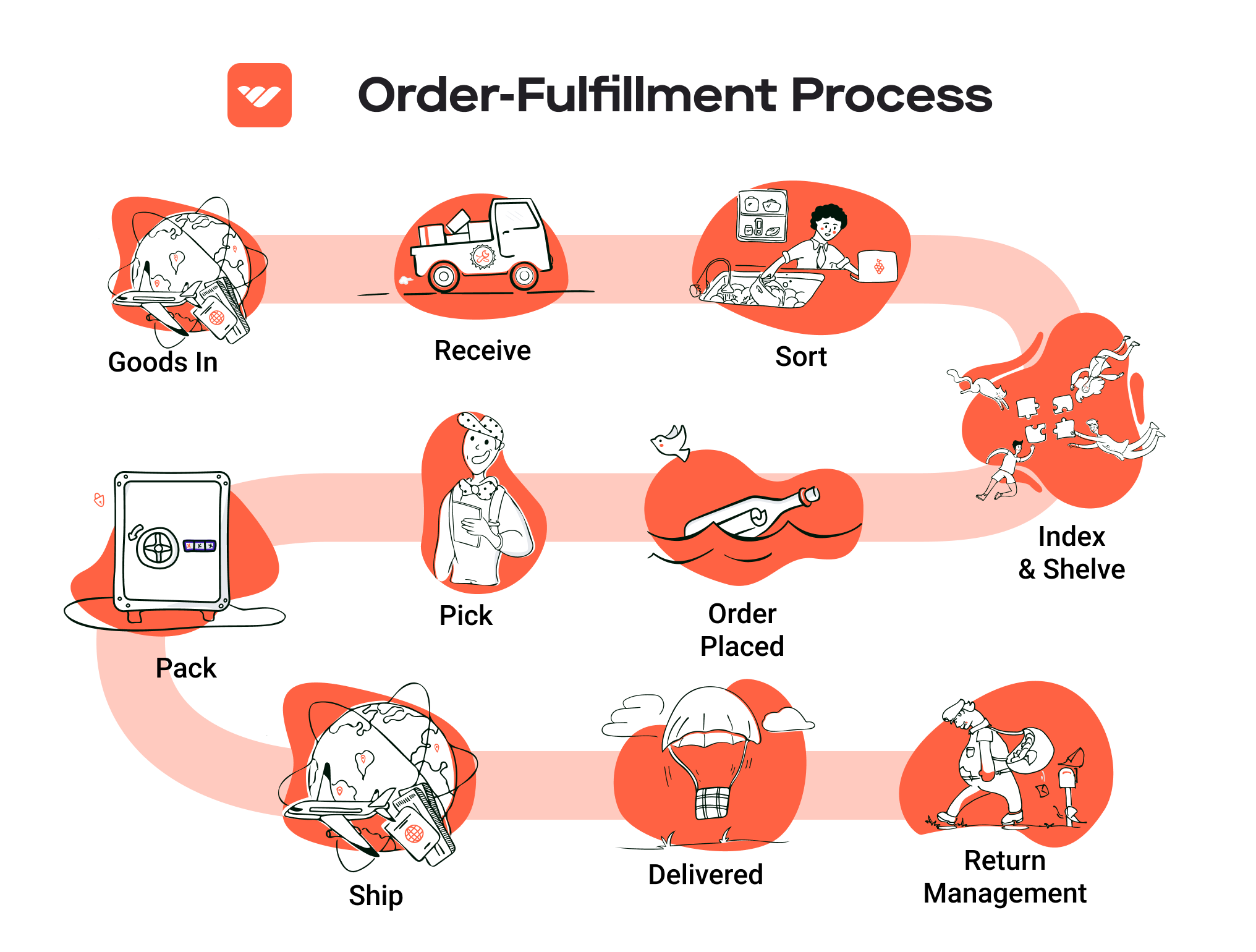
Commingling Risks
When using FBA, sellers’ products may be commingled with other sellers’ inventory. This means that there is a risk of receiving returns or complaints related to products that do not belong to the seller. For instance, if a customer returns a defective item, it may be hard to track down the origin, leading to potential quality control issues and affecting the seller’s reputation.
Who is FBA Best For?
Fulfillment by Amazon is particularly advantageous for specific types of sellers:
- New Sellers: Those just starting can benefit from Amazon’s established logistics and customer service infrastructure, reducing the barriers to entry in the competitive e-commerce landscape.
- Small to Medium-Sized Businesses: Companies that may not have the resources to build their own logistics network can leverage FBA to scale their operations efficiently.
- Businesses with High Demand: Sellers with popular products that can move quickly will find FBA beneficial, as it can help manage high volumes of orders without the need for extensive warehousing and staffing.
- Sellers Focused on Growth: Entrepreneurs looking to expand their market reach and brand recognition can use FBA to tap into Amazon’s vast customer base, increasing sales potential.
In conclusion, Fulfillment by Amazon presents an effective solution for many e-commerce business owners, providing a blend of convenience, customer trust, and operational efficiency. However, it is essential to weigh the associated costs and complexities against the benefits to determine if FBA aligns with your business goals. Understanding the intricacies of FBA will enable sellers to make informed decisions, optimizing their operations for scale and success.
Core Services Offered by Fulfillment Centers
Inventory Management & Warehousing
Inventory management and warehousing are foundational services provided by fulfillment centers, ensuring that e-commerce businesses maintain optimal stock levels while minimizing storage costs. A fulfillment center like Amazon’s PAE2, with its massive 2.9 million square feet of space, can store millions of items efficiently.
What It Is: This service involves receiving inventory from suppliers, storing it in a systematic manner, and tracking stock levels in real-time. Advanced inventory management systems enable fulfillment centers to monitor stock levels, reorder points, and product locations within the warehouse.
Benefits:
1. Cost Efficiency: By outsourcing inventory management to a fulfillment center, e-commerce businesses can avoid the overhead costs of maintaining their own warehouse, including rent, utilities, and staffing.
2. Scalability: As a business grows, its storage needs can fluctuate significantly. Fulfillment centers allow businesses to scale their inventory storage up or down based on demand without the hassle of moving locations or investing in additional infrastructure.
3. Real-Time Data Access: Many fulfillment centers provide integrated software solutions that allow businesses to access real-time data on inventory levels, sales trends, and stock movement. This transparency helps in making informed purchasing and marketing decisions.
Pick and Pack Services
Pick and pack services are essential for fulfilling customer orders quickly and accurately. This process involves selecting the right items from the warehouse and packaging them for shipment.
What It Is: When an order is placed, fulfillment center staff (or robots, as seen in PAE2) retrieve the items from storage, prepare them for shipping by packing them securely, and label them for delivery.
Benefits:
1. Speed: Fulfillment centers are designed to process orders rapidly. Automated systems and well-trained staff work together to ensure that orders are picked and packed efficiently, reducing delivery times significantly.
2. Accuracy: Advanced technology, such as barcode scanning and inventory management systems, helps minimize errors during the picking process. This accuracy reduces the likelihood of returns due to incorrect items being sent to customers.
3. Custom Packaging: Fulfillment centers often offer options for customized packaging, which can enhance brand presentation and improve customer satisfaction. This is especially important for e-commerce businesses looking to differentiate themselves in a competitive market.
Kitting and Assembly
Kitting and assembly services allow e-commerce businesses to offer bundled products or complex items that require assembly before shipping.
What It Is: This service involves gathering individual items and assembling them into a single kit or product. For example, a fulfillment center may bundle a camera with accessories like a case and tripod, or assemble furniture pieces before shipping.
Benefits:
1. Enhanced Product Offerings: Kitting enables businesses to create unique product bundles that can attract customers looking for convenience or value, potentially increasing average order value.
2. Streamlined Operations: By outsourcing kitting and assembly, businesses can focus on their core operations, such as marketing and customer service, rather than dealing with the complexities of product assembly.
3. Reduced Shipping Costs: Bundling products into a single package can reduce shipping costs compared to sending multiple separate items. This efficiency can lead to better margins for e-commerce businesses.
Returns Management (Reverse Logistics)
Returns management, or reverse logistics, is a critical service for e-commerce businesses, as managing returns effectively can significantly impact customer satisfaction and profitability.
What It Is: This service involves handling returned items, including processing returns, inspecting products for damage, restocking items, and managing refunds or exchanges.
Benefits:
1. Customer Satisfaction: Efficient returns management processes help ensure that customers have a positive experience when returning items, which can lead to repeat business and positive reviews.
2. Inventory Recovery: By effectively processing returns, fulfillment centers can quickly restock items that are still sellable, minimizing losses and maximizing inventory turnover.
3. Data Insights: Returns management can provide valuable insights into product performance and customer preferences. Analyzing return reasons helps businesses identify potential product issues and improve their offerings.
In summary, partnering with a fulfillment center provides e-commerce businesses with essential services that not only streamline operations but also enhance customer satisfaction and support growth. By leveraging these core services, businesses can focus on strategic initiatives while leaving logistics in the hands of experts.
How to Choose a Fulfillment Partner: A 6-Point Checklist
Location & Warehouse Network
Importance: The location of your fulfillment partner’s warehouses can significantly impact shipping times and costs. Being closer to your customer base can lead to faster deliveries, which is crucial for customer satisfaction and retention.
Questions to Ask:
1. Where are your warehouses located? Understanding their geographic footprint helps you assess potential shipping times to your target markets.
2. Do you have a network of warehouses? A wider network can offer more strategic advantages in terms of distribution and shipping efficiency.
3. How do you handle last-mile delivery? Knowing how they manage the final leg of delivery can inform you about potential delays or additional costs.
Technology & Integrations
Importance: An effective fulfillment partner should leverage technology to streamline processes, reduce errors, and provide real-time visibility into inventory and order status. Seamless integrations with your existing e-commerce platforms (like Amazon, Shopify, etc.) are also crucial.
Questions to Ask:
1. What order management system do you use? Understanding their technology stack can give insights into their efficiency and capabilities.
2. Can your system integrate with my e-commerce platform? Confirming compatibility ensures that data flows smoothly between your systems without manual intervention.
3. Do you offer real-time tracking for orders? Real-time visibility into order status is essential for managing customer expectations and operational efficiency.
Specializations (e.g., Cold Storage, Oversized Items)
Importance: Depending on your product range, you may need a fulfillment partner that specializes in certain areas, such as cold storage for perishable goods or handling oversized items. Specialized facilities can ensure compliance with regulations and maintain product quality.
Questions to Ask:
1. What types of products do you specialize in? This will help you determine if they can effectively handle your specific product types.
2. Do you have facilities for temperature-sensitive items? If you deal with perishables, inquire about their cold storage capabilities.
3. How do you handle oversized or heavy items? Assess their experience and equipment for managing such products, as this can affect shipping costs and delivery times.
Scalability & Capacity
Importance: As your business grows, your fulfillment needs will change. A good partner should be able to scale operations up or down based on your demand fluctuations without compromising service quality.
Questions to Ask:
1. What is your current capacity, and how do you handle peak seasons? Understanding their capacity helps you gauge whether they can meet your needs during high-demand periods.
2. How quickly can you scale operations? Knowing their response time to increased demand is critical, especially during peak seasons like holidays.
3. What systems do you have in place for inventory management? Efficient inventory management systems are essential for scaling operations smoothly and minimizing stockouts or overstock situations.
Pricing and Contracts
Importance: Transparent pricing structures and flexible contracts are vital for budgeting and financial planning. Hidden fees can erode your margins, so understanding the cost breakdown is essential.
Questions to Ask:
1. Can you provide a detailed breakdown of your pricing model? Clarity on costs will help you avoid unexpected expenses.
2. Are there any additional fees (e.g., storage, handling, returns)? Knowing all potential costs upfront allows for better financial forecasting.
3. What are the terms of your contracts? Inquire about contract length, termination clauses, and any penalties for early termination to ensure you’re not locked into unfavorable terms.
Customer Support & Reviews
Importance: Excellent customer support is crucial for addressing issues quickly and maintaining operational efficiency. Additionally, reviews and testimonials from other clients can provide insights into the partner’s reliability and service quality.
Questions to Ask:
1. What customer support channels do you offer? Ensure they provide multiple ways to reach support (phone, email, chat) and assess their response times.
2. Can you share references or case studies from similar businesses? Speaking with current or past clients can provide valuable insights into their service quality and reliability.
3. How do you handle issues or complaints? Understanding their problem-resolution process can help you gauge their commitment to customer satisfaction.
Conclusion
Choosing the right fulfillment partner is a critical decision that can significantly impact your e-commerce business’s success. By using this checklist, you can systematically evaluate potential partners based on their location, technology, specializations, scalability, pricing, and customer support. Taking the time to ask the right questions will ensure you make an informed choice that aligns with your business goals, ultimately leading to enhanced operational efficiency and customer satisfaction.
Understanding Fulfillment Pricing: A Breakdown of Common Fees
Initial Setup Fees
When partnering with a fulfillment center like Amazon’s PAE2, businesses often encounter initial setup fees. These charges cover the administrative costs associated with onboarding your products into the system. Initial setup fees can vary based on the complexity of your inventory, the number of SKUs (stock keeping units), and the specific requirements of your business.
Typically, these fees may include costs for creating product listings, establishing your account, and integrating your e-commerce platform with the fulfillment center’s systems. It’s essential to clarify what is included in these fees upfront to avoid unexpected costs later on.
Receiving Fees
Receiving fees are charged when your inventory arrives at the fulfillment center. This fee compensates the center for unloading, inspecting, and entering your products into their inventory system. The calculation for receiving fees usually depends on the volume of goods being received—often measured by the number of pallets or individual items.
For instance, a fulfillment center may charge a flat rate per pallet or a per-item fee based on the total number of items received. Understanding this fee structure is vital, as discrepancies in inventory counts can lead to additional charges or issues with order fulfillment later.
Storage Fees (per pallet/bin)
Storage fees are ongoing costs incurred for keeping your inventory in the fulfillment center. These fees are typically calculated on a monthly basis, either per pallet or per bin, depending on the storage arrangement and the fulfillment center’s policies.
The price can fluctuate based on the time of year; for example, during peak seasons like the holidays, storage fees may increase due to higher demand for warehouse space. To manage these costs effectively, businesses should regularly analyze their inventory turnover rates and optimize stock levels to minimize storage fees.
Pick & Pack Fees (per item/order)
Pick and pack fees are charged for the labor involved in selecting items from storage and preparing them for shipment. This fee is generally calculated on a per-item basis, meaning the more items included in an order, the higher the pick and pack fee.
Additionally, some fulfillment centers may have a minimum order fee, which could affect smaller shipments. Understanding how these fees are structured can help businesses optimize their order sizes and packaging methods to reduce overall fulfillment costs.
Shipping Fees
Shipping fees are perhaps the most variable component of fulfillment pricing. These charges cover the cost of transporting orders from the fulfillment center to the customer’s address. Shipping fees can be affected by several factors, including the shipping method chosen (standard, expedited, etc.), the destination, the weight and dimensions of the package, and any special handling requirements.
Many fulfillment centers, including Amazon, offer discounted shipping rates due to their volume of shipments. However, it’s essential to compare these rates against other carriers to ensure you’re getting the best deal for your business.
Tips for Getting an Accurate Quote
-
Be Transparent About Your Needs: Clearly communicate your expected order volumes, types of products, and any special handling requirements. This information will help fulfillment centers provide a more accurate estimate.
-
Request Detailed Breakdown: When obtaining quotes, ask for a detailed breakdown of all fees involved. This will allow you to compare different fulfillment centers more effectively.
-
Consider Seasonal Variations: If your business experiences seasonal fluctuations, inquire about how fees may change during peak periods. This foresight will help in budgeting effectively.
-
Negotiate Terms: Don’t hesitate to negotiate terms and fees. Many fulfillment centers are open to discussions, especially if you can guarantee a certain volume of business.
-
Test the Waters: If possible, start with a smaller batch of inventory to assess the fulfillment center’s services before committing to larger volumes. This approach allows you to evaluate the efficiency and reliability of their operations without significant upfront investment.
By understanding these common fulfillment pricing models and strategically managing your relationship with fulfillment centers, you can optimize costs and scale your e-commerce operations effectively.
Frequently Asked Questions (FAQs) about Fulfillment
1. What is the Amazon PAE2 fulfillment center?
The Amazon PAE2 fulfillment center is the largest warehouse in Washington state, spanning approximately 2.9 million square feet. Located in Arlington, it is designed to store up to 40 million items and efficiently process tens of thousands of orders daily. This facility utilizes advanced robotics and human workers to handle inventory, ensuring quick and reliable delivery to customers.
2. How does the fulfillment process work at PAE2?
At PAE2, the fulfillment process involves several key phases. Initially, products are received and stored in the warehouse. When an order is placed, items are retrieved via a combination of automated systems and human effort, packed securely, and loaded onto trailers for delivery. This streamlined approach allows Amazon to meet high customer demand efficiently.
3. What types of products can be stored at the PAE2 fulfillment center?
The PAE2 center can accommodate a wide range of products, particularly those that are less than 18 inches in length and weigh under 25 pounds. This includes items such as electronics, household goods, and small appliances. The facility is optimized for handling diverse inventory types to cater to various customer needs.
4. How many employees work at the PAE2 fulfillment center?
The PAE2 fulfillment center is expected to employ over 1,200 people, with plans for this number to increase as the facility ramps up operations. The center provides local job opportunities and aims to hire more employees before peak shopping seasons, such as the holidays.
5. What is the difference between a warehouse and a fulfillment center?
A warehouse is primarily used for storing goods, while a fulfillment center specializes in processing orders and managing inventory for e-commerce. Fulfillment centers often incorporate advanced technologies and logistics strategies to ensure quick order processing and delivery, making them essential for online retailers like Amazon.
6. What is a third-party logistics provider (3PL)?
A third-party logistics provider (3PL) is a company that offers outsourced logistics services, including warehousing, fulfillment, and transportation management. Businesses often partner with 3PLs to streamline their supply chain operations, reduce costs, and focus on their core competencies, allowing them to scale more effectively.
7. How much do fulfillment services cost?
The cost of fulfillment services can vary widely based on factors such as the volume of orders, types of products, and specific services offered. Generally, fees can include storage costs, picking and packing charges, shipping fees, and any additional services like returns processing. Businesses should obtain quotes from fulfillment centers to understand their specific pricing structures.
8. How does Amazon ensure the safety of its workers at the PAE2 center?
Amazon has committed to investing significantly in improving worker safety across its fulfillment centers, including PAE2. The company has implemented safety protocols, training programs, and technological advancements aimed at reducing workplace injuries and ensuring a safer working environment for employees.
9. What technology is used in the PAE2 fulfillment center?
The PAE2 fulfillment center utilizes advanced robotics, including a system called Robin, which assists in moving, retrieving, and storing packages. This technology enhances efficiency and helps reduce the physical workload on employees, allowing them to focus on other critical tasks within the fulfillment process.
10. What should businesses consider when choosing a fulfillment center?
When selecting a fulfillment center, businesses should evaluate factors such as location, capacity, technology integration, service offerings, and pricing. It’s essential to choose a fulfillment partner that aligns with your business needs and can scale operations as your sales grow, ensuring a seamless customer experience.
Conclusion: Is Outsourcing Fulfillment the Right Move for Your Business?
The Strategic Advantage of Outsourcing Fulfillment
Outsourcing fulfillment can be a transformative decision for e-commerce businesses seeking to scale efficiently and effectively. The key benefits of utilizing a fulfillment service are significant and multifaceted. First and foremost, outsourcing allows businesses to save precious time. By delegating logistics to experts, you can focus on core activities such as product development, marketing, and customer engagement. This shift in focus can lead to enhanced innovation and overall business growth.
Scalability is another critical advantage. As your sales volume increases, a dedicated fulfillment partner can seamlessly accommodate fluctuating demand without the need for you to invest in additional infrastructure or labor. For instance, companies like Amazon’s PAE2 fulfillment center demonstrate how advanced logistics capabilities, including automated systems and extensive storage capacity, can streamline order processing and delivery. This scalability ensures that you can meet customer expectations, particularly during peak seasons, without compromising service quality.
Moreover, partnering with a fulfillment provider brings specialized expertise to your operations. These partners are often well-versed in the complexities of inventory management, shipping regulations, and technology integration. Their experience can help you navigate challenges that may otherwise impede your growth.
However, the success of outsourcing fulfillment hinges on selecting the right partner. It’s essential to evaluate potential providers based on their technology, reliability, and customer service standards to ensure they align with your business goals.
Call to Action
To determine if outsourcing fulfillment is the right strategic move for your business, conduct a thorough audit of your current shipping processes. Assess efficiency, costs, and customer satisfaction levels. This evaluation will provide valuable insights into whether a fulfillment partner can enhance your operations and drive your growth ambitions forward. Take the next step toward optimizing your logistics and consider how a fulfillment service can support your long-term success.
Important Disclaimer
⚠️ Important Disclaimer
The information in this guide is for educational purposes. Fulfillment services, pricing, and platform features change frequently. Always conduct your own due diligence and consult with providers directly before making business decisions.
